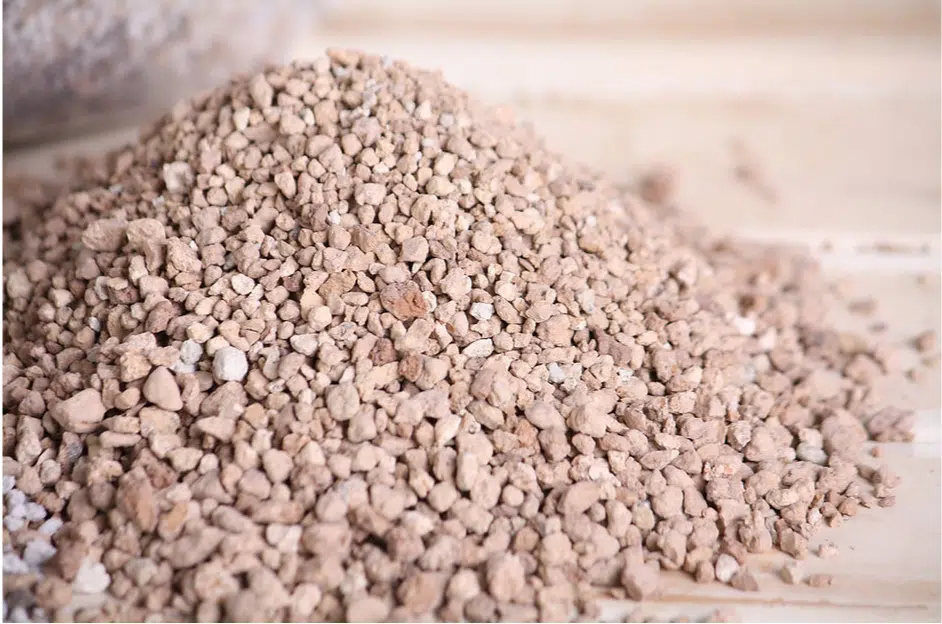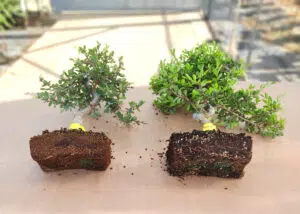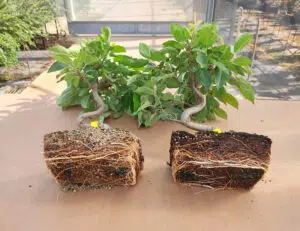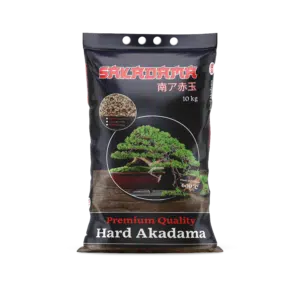How to use Sakadama soil in bonsai cultivation

During the last months we have been introducing you to this new bonsai substrate, in this blog we focus on how to use Sakadama in your bonsai soil mixtures.
Main benefits of Sakadama for bonsai soil mixtures
We can grow our trees using it as the only substrate, but the optimal use of Sakadama is obtained by mixing it with other substrates for bonsai. As a result, it gives to the mixture unique properties:
- Greater durability. Sakadama is a material with an exceptional hardness as a substrate property and also due to the heat treatment at 600ºC. Its contribution
in the bonsai substrate mixture will make it more resistant to handling and cultivation, which will extend the time between transplants. If we try to crush the grains with our fingers, the material resists and does not break like others. - Greater resistance to adverse weather conditions. Recent studies show that Sakadama is more resistant than other materials commonly used as substrate in bonsai cultivation to adverse climatic conditions, especially low temperatures and frost. These studies corroborated that, due to the structural change that occurs in the Sakadama particles in the manufacturing process, this material was the one that presented the least degradation after being subjected to various frost cycles.
- Cation exchange capacity. Due to its nature and manufacturing process, it has a high porosity. Providing it of a high absorption capacity of nutrients, which will be available for the roots of the bonsai.
- Greater drainage capacity and oxygenation of the roots. In the manufacturing process of Sakadama, an additional sieving is carried out, guaranteeing
the granulometry of the product and the absence of the finest particles. Dust in bonsai cultivation is an undesirable material, as it obstructs the drainage of the substrate, facilitating undesirable root asphyxia and consequent rotting of the roots. - Pathogens and weed reduction. The heat treatment at 600 °C during the manufacturing process eliminates the presence of these organisms. Its contribution
in the mixture reduces the chances of their development.
Most common bonsai soil mixtures with Sakadama
The optimal use of Sakadama is obtained when it is used as a component of mixtures that form the soil for bonsai together with other materials, taking into account that it will contribute to the substrate the already described qualities of absence of dust, durability, drainage, cation exchange capacity and sanitation, among other properties.
Depending on the species of bonsai and the objective to be achieved with its cultivation, mixtures of Sakadama with Akadama, Pomice, and Terrabonsai, for example, are common, resulting in substrates containing two or more of these components.
Knowing the kinds of soil, with their pros and cons, you can make your own mixtures. Below, we propose some examples of substrates that include Sakadama (proportions in volume), although you can adapt the proportions according to the irrigation method, geographical area, water quality, fertilizing system, etc.
SAKADAMA 40% + TERRABONSAI 60%
The 60% of Terrabonsai makes of it a standard mix valid for all types of bonsai, especially for indoor ones. Ideal for beginners and for the maintenance of finished trees.
Terrabonsai is a homogeneous mixture of blond peat, volcanic clay and Akadama that results in a substrate with unique characteristics. Owing to the Terrabonsai, this soil mixture will allow us to space the watering. It will retain the mineral fertilizers effectively and will improve the drainage.
It has a neutral PH that favours the absorption of nutrients. If we mix Sakadama with Terrabonsai at the indicated proportions in volume, we enhance the drainage of the substrate and its durability.
SAKADAMA 40% + TERRABONSAI 40% + POMICE 20%
This bonsai soil mixture, in which Pomice is introduced, is suitable for Mediterranean and evergreen trees. These quantities make it possible to produce trees with great vigour that will respond adequately to pruning and pruning.
It results in a substrate that is both draining and with good absorption of water and nutrients immediately available to the plant, at the same time that the periods between transplants are spaced as it is more difficult to degrade.
SAKADAMA 30% + KIRYUZUNA 30% + AKADAMA 40%
The mixture with Kiryuzuna and Akadama is especially suitable for the cultivation of conifers bonsai. It is a very draining soil mixture, which will allow the correct development of trees that are not very vigorous. It avoids root asphyxia and root rot.
This mixture requires more attention with the watering. It will also require the use of organic fertilizers that release nutrients slowly.
SAKADAMA 50% + AKADAMA 50%
Although it can be used for all types of bonsai, it is especially suitable for deciduous trees. It requires a good knowledge of the bonsai and needs good watering control.
If we add Sakadama to the bonsai mixture, it will provide more durability to the substrate, thus spacing the time between transplants. On the other hand, if used in areas with low temperatures and frost, the substrate will show less degradation.
How to choose the appropriate Sakadama granulometry
The size of the bonsai determines the grain size to be used.
Medium grain (5 to 8 mm). Bonsai with a pot width of more than 25 cm.
Small grain (3 to 5 mm). Bonsai with pot width less than 25 cm.
Shohin grain (1 to 3 mm). For small bonsai, Mame or Shohin.
At this point, you know more about the mixtures and management of Sakadama soil in bonsai cultivation, you will know a little more about this substrate. In conclusion, there are many possibilities depending on the species, conditions, knowledge… We invite you to try our proposals and to discover new options for your bonsai.
Categories
Bonsai cultivation and care (60)
Bonsai gift (2)
Bonsai pests and diseases (7)
Bonsai repotting (3)
Bonsai species (1)
bonsai substrates (2)
Bonsai summer (1)
bonsai tools (1)
Bonsai work (13)
Ceramic pots (3)
Chinese culture (2)
Chinese culture (1)
Coniferous bonsai (2)
Conifers (1)



